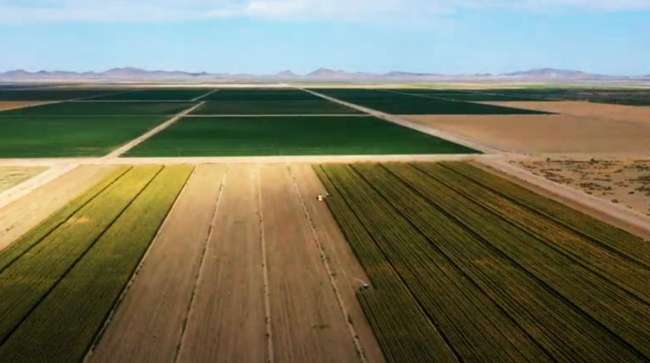Senior Reporter
Fortistar, Paloma Dairy Partner on RNG Production to Fuel Trucks

[Stay on top of transportation news: Get TTNews in your inbox.]
Private investment firm Fortistar and large family-owned Paloma Dairy announced they are constructing a dairy digester facility to capture methane and produce renewable natural gas to fuel the Class 8 market, as well as for a public utility.
The Sunoma Renewable Biofuel Project facility will produce 1.6 million gasoline gallon equivalents of vehicle fuel annually for the heavy-duty trucking sector — enough fuel to move 10.4 million miles of freight based on a fuel efficiency of 6.5 miles per gallon, according to White Plains, N.Y.-based Fortistar.
“From a financial component, the scope of their dairy, the location, the proximity to infrastructure checked the boxes our team was looking for,” Chuck Bryceland, general manager at Fortistar, told Transport Topics.
Paloma Dairy is a fourth-generation dairy farm in Gila Bend, Ariz. It has 10,000 animals and produces cow feed from alfalfa, corn silage, wheat and barley across 7,000 acres of farmland.
TruStar Energy, a Fortistar company and developer of RNG fueling stations, will market and deliver the fuel.
In partnership with Paloma Dairy, we are excited to announce construction has begun on our new dairy digester #RNG facility, the Sunoma #Renewable #Biofuel Project. The facility will produce enough fuel to move 10 million miles of freight. Read more here: https://t.co/AgVvGHowmZ — Fortistar RNG (@FortistarRNG) August 31, 2020
“We saw a great environmental and economic opportunity in the management of our manure and emissions,” Paloma Dairy’s manager, Robert Van Hofwegen, said in a release.
The project also will sell RNG to Southwest Gas Corp., which provides natural gas service to more than 2 million residential, commercial, and industrial customers in parts of Arizona, Nevada and California, according to the Las Vegas-based company — a subsidiary of Southwest Gas Holdings Inc.
Methane-based renewable fuel is some of the most valuable from an environmental perspective, Bryceland said
Dairies can have a minus 300 carbon intensity score — the low carbon fuel standard value is higher the lower your carbon intensity (CI) score is, he said. “So there is an economic element that’s tied to the source of the fuel. So in landfill gas, for instance, that CI is around 40-ish, on average compared with 100 for diesel.”

Transport Topics introduces its newest digital interview series, Newsmakers, aimed at helping leaders in trucking and freight transportation navigate turbulent times. Audience members will gain access to the industry's leading expert in their particular field and the thoughtful moderation of a Transport Topics journalist. Our second episode — "The Evolution of Electric Trucks" — featured Nikola founder and executive chairman Trevor Milton. To view the replay, complete this form.
Since 2011, the Low Carbon Fuel Standard has been a cornerstone of California’s effort to reduce greenhouse gas emissions. It compares fuels to an annually declining baseline. If a fuel has a carbon intensity above that baseline it generates a deficit for the producer. If the intensity is below the baseline it can generate credits which may then be sold to a producer who has a deficit, according to the California Air Resources Board. Other states have shown interest in a similar approach.
Meanwhile, when heavy-duty electric trucks are available, Bryceland said, Fortistar can use its RNG to power the grid that can charge the trucks. “But today electrification for heavy-duty fleets is not available while natural gas engines are reducing freight emissions today.”
He added CNG doesn’t get enough respect and RNG is never going to fuel the whole national fleet.
“If we get really good and efficient in capturing animal waste, wastewater and landfill gas, there’s still not enough RNG to fuel the whole transportation system. So we need multiple solutions,” he said. “We happen to believe RNG is the best currently available solution for class 8 fleets to reduce emissions today.”
Fortistar reported the project is the third of 12 new RNG projects totaling nearly $500 million in capital that the company expects to begin over the next year. These new projects will produce 120 million gasoline gallon equivalents of RNG over the next three years and reduce U.S. transportation emissions by 2 million metric tons of carbon dioxide annually, which is the equivalent of taking approximately 424,628 passenger cars off the road.
In a recent related post, Microsoft founder Bill Gates wrote that the coronavirus pandemic has also reminded us how much innovation is needed to prevent a climate disaster.
If we’re going to address climate change, we need to find new ways to do things that don’t release greenhouse gases—including how we move around. https://t.co/ElpoZs2ZHG — Bill Gates (@BillGates) August 26, 2020
“The best numbers I have seen estimate that the economic slowdown due to COVID-19 reduced global emissions by around 8%. That’s not nothing, but the austerity that got us there obviously isn’t sustainable,” Gates said. “If we’re going to address climate change, we need to find new ways to do things that don’t release greenhouse gases, including how we move around.”
Want more news? Listen to today's daily briefing:
Subscribe: Apple Podcasts | Spotify | Amazon Alexa | Google Assistant | More


